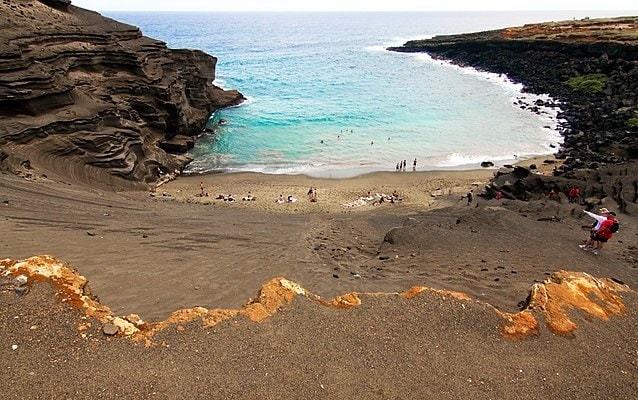Last updated: August 16, 2019
Place
South Point Complex

Photo by Pushkr, CC BY 2.0
The South Point Complex, is located at the southern tip of the Island of Hawai'i on Ka Lae(the point), 16 miles south of the town of Naalehu. It is the southernmost point in both the Hawaiian Islands and the United States and is made up of a group of sites which are among the oldest in the Islands.
The South Point Complex is thought to be the site of one of the earliest settlements in the Hawaiian Islands and is believed to be the landing place of Hawaii's first inhabitants. One of the oldest known ancient Hawaiian habitations was uncovered at the South Point Complex Pu'u Ali'i (Hill of Chiefs) sand dune in 1956 by an archeological team from the Bishop Museum. The remains of a house, a fire hearth, and over 14,000 artifacts were found at the site, including coral and stone abraders (files used to make fish hooks) and over 60 different types of large fish hooks. The site appears to have been used continuously for fishing and as a settlement over a period of more than a thousand years.
South Point is a flat, grassy, windy plateau situated on high cliffs above the ocean. The waters off the point are very deep and dangerous with strong currents and are well known for their abundance of large fish such as ahi (yellow tuna), mahimahi, and marlin. Because it's difficult to fish from boats off South Point, the ancient Hawaiians, who fished from canoes, drilled mooring holes through rock ledges on the plateau. Fishermen would pass strong ropes through the mooring holes, tie them off, and then tie the loose ends to their canoes. This would allow the currents to carry the canoes into deep-water fishing grounds without being swept out to sea. Mooring holes can be seen in the rocks to the west of the Kalalea Heiau on the South Point Complex. There are also numerous salt pans located around the Complex. The ancient Hawaiians carved these shallow rectangular "pans" into the lava rock and filled them with ocean saltwater. When the water evaporated, the salt that was left behind was used to preserve fish.
The best evidence of South Point's historical value as a fishing spot is Kalalea Heiau, an ancient fishing shrine (ko'a) to Ku'ula, the god of fishing. The heiau (place of worship) has stone walls that form a nearly perfect square of approximately 42 feet by 38 feet. The walls are four feet high at the north end of the heiau and rise to six feet at the south end. Just outside the west wall is a 20 by 20-foot platform paved with stones, which served as a place to prepare fish for meals or sacrifices. Local fishermen still visit Kalalea Heiau to leave offerings in the hopes of finding good fishing off of South Point or as thanks for a successful catch.
In addition to the heiau, several sacred standing stones are located in the vicinity. On the main platform outside the heiau is the stone called Hina (female), and on the smaller stone terrace to the north is Ku'ulakai (male), associated with Kanaloa, the god of the ocean. Twelve feet to the north are the stones Makaunulau (named for a star used for navigation) and Ai'ai (a young dependent or ward) and south of the heiau is the stone called Wahine hele (place from where the women leave). Located at the shoreline is the stone named Pohakuwa'a Kauhi (canoe rock by the shrubs) which was used to focus meditation before long canoe journeys. Just offshore is Pohakuokeau (stone of the currents or stone of the years) which was believed to turn over when a change in government occurred. Lastly, there is a sacred stone called Ku'ula, located inside the heiau's north wall.
Also located at South Point is Papakolea Beach, one of only four green sand beaches in the world. The beach gets its distinctive color from olivine crystals, more commonly known as peridot. The crystals erode out of ancient basalt lava flows found within the 49,000 year old eroded Pu'u Mahana cinder cone that encircles the beach. The olivine crystals are heavier than the sand grains on the beach and remain behind when the sand is washed away by waves, giving the beach area near the water a distinctive green color.
South Point Complex, a National Historic Landmark, is located on the southernmost tip of the Island of Hawai'i, 16 miles south of Naalehu, HI. The site is at the end of South Point Road, 12 miles south of Hawaii Route 11 (Hawaii Belt Road). Papakolea Beach is 2.5 miles east of Kalalea Heiau and can be reached by vehicle or by hiking along the shoreline. Because of the powerful currents, swimming is not advised in the South Point area. For more information, visit the Hawaii Tourism Authority.
